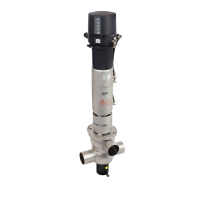11
APV_DA4_UK-1_102018.indd
UK
Double Seat Mix Proof Valve
APV DELTA DA4
Instruction Manual: UK - rev. 1
APV
6. Cleaning
In the cleaning process of DA4 valves, distinction is made between
three areas: Flow areas, Seal surfaces and seat area, and Leakage
chamber.
6.1. Flow areas
The CIP-fluid cleans the upper and lower passages of the valve
during CIP.
6.2. Seal surfaces and seat area
The seal surfaces of the upper area (upper shaft and seat seal) and
the lower area (lower shaft and seat seal) are flushed and cleaned
when the individual valve shafts are lifted during cleaning. The seat
area and leakage chamber are also cleaned during this process.
6.3. Leakage chamber
CIP spraying cleans the leakage chamber. The cleaning connection
is at item C in fig. 6.3.
CIP spraying does not produce pressure build-up in the leakage
chamber. SPX FLOW recommends performing CIP-spraying in
the closed valve position; however, it can also be done in the open
valve position.
Under standard conditions 15 valves DN 40-100 / 1,5"-4" can be
cleaned via one spray distribution line DN 25.
6.4. Cleaning recommendation
Cleaning steps Seat lifting cycle CIP spraying
pre-flushing – 3 x 10 sec.
caustic flushing 80°C 3 x 5 sec. 3 x 10 sec.
intermediate flushing 2 x 5 sec. 2 x 10 sec.
acid flushing 3 x 5 sec. 3 x 10 sec.
subsequent flushing 2 x 5 sec. 2 x 10 sec.
- The lifting cycles refer to a cleaning pressure of p = 2-5 bar.
- Depending on the pressure ratio, cleaning temperatures, cleaning
steps and degree of soiling, different cycles must be adjusted.
- Flushing quantities per CIP spraying cycle:
DN 40-100/1,5-4" about 1,2 ltr/10s
- Cleaning pressure at CIP cleaning connection: min. 2 bar
max. 5 bar
Caution!
The cleaning liquid applied must be compatible with the respective
seal material.
C
CIP spraying
free drain
CIP liquid
fig. 6.3.
!

